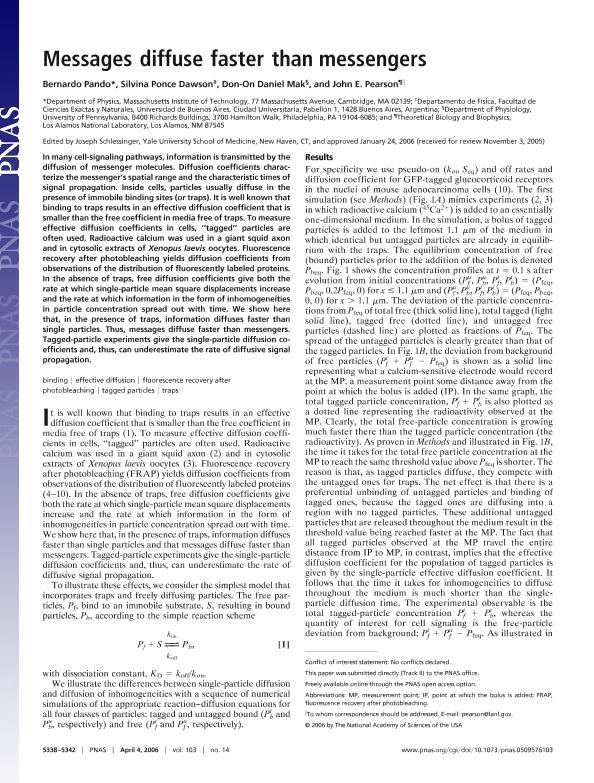Mostrar el registro sencillo del ítem
dc.contributor.author
Pando, Bernardo
dc.contributor.author
Ponce Dawson, Silvina Martha

dc.contributor.author
Mak, Don-On Daniel
dc.contributor.author
Pearson, John E.
dc.date.available
2019-03-18T16:15:38Z
dc.date.issued
2006-12
dc.identifier.citation
Pando, Bernardo; Ponce Dawson, Silvina Martha; Mak, Don-On Daniel; Pearson, John E.; Messages diffuse faster than messengers; National Academy of Sciences; Proceedings of the National Academy of Sciences of The United States of America; 103; 14; 12-2006; 5338-5342
dc.identifier.issn
0027-8424
dc.identifier.uri
http://hdl.handle.net/11336/71857
dc.description.abstract
In many cell-signaling pathways, information is transmitted by the diffusion of messenger molecules. Diffusion coefficients characterize the messenger's spatial range and the characteristic times of signal propagation. Inside cells, particles usually diffuse in the presence of immobile binding sites (or traps). It is well known that binding to traps results in an effective diffusion coefficient that is smaller than the free coefficient in media free of traps. To measure effective diffusion coefficients in cells, "tagged" particles are often used. Radioactive calcium was used in a giant squid axon and in cytosolic extracts of Xenopus laevis oocytes. Fluorescence recovery after photobleaching yields diffusion coefficients from observations of the distribution of fluorescently labeled proteins. In the absence of traps, free diffusion coefficients give both the rate at which single-particle mean square displacements increase and the rate at which information in the form of inhomogeneities in particle concentration spread out with time. We show here that, in the presence of traps, information diffuses faster than single particles. Thus, messages diffuse faster than messengers. Tagged-particle experiments give the single-particle diffusion coefficients and, thus, can underestimate the rate of diffusive signal propagation. © 2006 by The National Academy of Sciences of the USA.
dc.format
application/pdf
dc.language.iso
eng
dc.publisher
National Academy of Sciences

dc.rights
info:eu-repo/semantics/openAccess
dc.rights.uri
https://creativecommons.org/licenses/by-nc-sa/2.5/ar/
dc.subject
Binding
dc.subject
Effective Diffusion
dc.subject
Fluorescence Recovery After Photobleaching
dc.subject
Tagged Particles
dc.subject
Traps
dc.subject.classification
Otras Ciencias Biológicas

dc.subject.classification
Ciencias Biológicas

dc.subject.classification
CIENCIAS NATURALES Y EXACTAS

dc.title
Messages diffuse faster than messengers
dc.type
info:eu-repo/semantics/article
dc.type
info:ar-repo/semantics/artículo
dc.type
info:eu-repo/semantics/publishedVersion
dc.date.updated
2019-03-15T18:51:11Z
dc.journal.volume
103
dc.journal.number
14
dc.journal.pagination
5338-5342
dc.journal.pais
Estados Unidos

dc.journal.ciudad
Washington DC, USA
dc.description.fil
Fil: Pando, Bernardo. Massachusetts Institute of Technology; Estados Unidos
dc.description.fil
Fil: Ponce Dawson, Silvina Martha. Consejo Nacional de Investigaciones Científicas y Técnicas. Oficina de Coordinación Administrativa Ciudad Universitaria. Instituto de Física de Buenos Aires. Universidad de Buenos Aires. Facultad de Ciencias Exactas y Naturales. Instituto de Física de Buenos Aires; Argentina
dc.description.fil
Fil: Mak, Don-On Daniel. University of Pennsylvania; Estados Unidos
dc.description.fil
Fil: Pearson, John E.. Los Alamos National Laboratory;
dc.journal.title
Proceedings of the National Academy of Sciences of The United States of America

dc.relation.alternativeid
info:eu-repo/semantics/altIdentifier/doi/http://dx.doi.org/10.1073/pnas.0509576103
Archivos asociados
